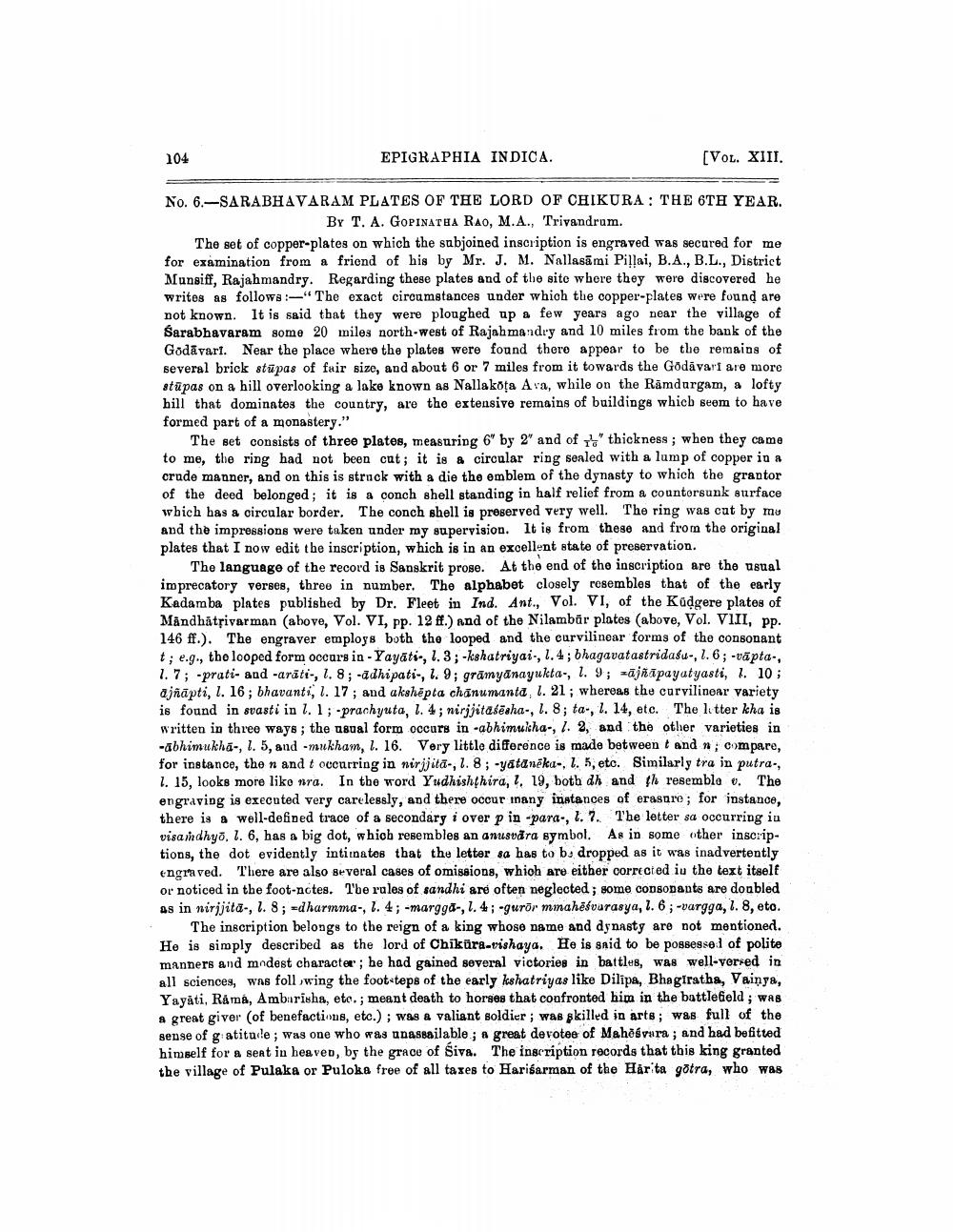________________
104
EPIGRAPHIA INDICA.
[VOL. XIII.
No. 6.-SARABHAVARAM PLATES OF THE LORD OF CHIKURA: THE 6TH YEAR.
BY T. A. GOPINATHA RAO, M.A., Trivandrum. The set of copper-plates on which the subjoined inscription is engraved was secured for me for examination from a friend of his by Mr. J. M. Nallasāmi Pillai, B.A., B.L., District Munsiff, Rajahmandry. Regarding these plates and of the site where they were discovered he writes as follows:-" The exact circumstances under which the copper-plates were found are not known. It is said that they were ploughed up a few years ago near the village of Sarabhavaram some 20 miles north-west of Rajahmandry and 10 miles from the bank of the Godāvari. Near the place where the plates were found there appear to be the remains of several brick stūpas of fair size, and about 6 or 7 miles from it towards the Godavari are more stūpas on a hill overlooking a lake known as Nallakota Ava, while on the Rämdurgam, a lofty hill that dominates the country, are the extensive remains of buildings whicb seem to have formed part of a monastery."
The set consists of three plates, measuring 6" by 2' and of thickness; when they came to me, the ring had not been cat; it is & circular ring sealed with a lump of copper in a crude manner, and on this is struck with a die the emblem of the dynasty to which the grantor of the deed belonged; it is a conch shell standing in half relief from a countorsunk surface which has a circular border. The conch shell is preserved very well. The ring was cut by mu and the impressions were taken under my supervision. It is from these and from the original plates that I now edit the inscription, which is in an excellent state of preservation.
The language of the record is Sanskrit prose. At the end of the inscription are the usual imprecatory verses, three in number. The alphabet closely resembles that of the early Kadamba plates published by Dr. Fleet in Ind. Ant., Vol. VI, of the Kudgere plates of Måndhätsivarman (above, Vol. VI, pp. 12 ff.) and of the Nilambär plates (above, Vol. VIII, pp. 146 ff.). The engraver employs both the looped and the curvilinear forms of the consonant t; e.g., the looped form oocars in - Yayāti, 1.3; -kshatriyai., 1.4; bhagavatastridasu-, 1.6; -väpta, 1.7; -prati- and -arāti., 1.8; -adhipati-, 1. 9; grāmyānayukta, l. 9; -ājñāpayatyasti, 1. 10 ; ajñāpti, 1. 16; bhavanti, 1. 17; and akshēpta chanumanta. 1. 21; whereas the curvilinear variety is found in svasti in l. l; prachyuta, 1.4; nirjjitaśēsha-, l. 8; ta-, l. 14, etc. The latter kha is written in three ways; the usual form occurs in -abhimukha-, l. 2, and the other varieties in -abhimukha-, 1. 5, and -mukham, l. 16. Very little difference is made between t and n; compare, for instance, the n and t occurring in nirjjitā, 1.8; -yatanēka-, 1. 5, etc. Similarly tra in putra., 1. 15, looks more like nra. In the word Yudhishthira, ?, 19, both dh and th resembla e. The engraving is executed very carelessly, and there occur any instances of erasure; for instance, there is a well-defined trace of a secondary i over p in para., 2.7. The letter sa occurring in visandhyo. 1. 6, has a big dot, which resembles an anusvåra symbol. As in some other inscriptions, the dot evidently intimates that the letter sa has to bdropped as it was inadvertently engraved. There are also Beveral cases of omissions, which are either corrected in the text itself or noticed in the foot-nctes. The rules of sandhi are often neglected; some consonants are doubled as in nirjjita., 1. 8; -dharmma-, 1.4; -margga-, 1.4; -gurör mmahēšvarasya, 1. 6; -vargga, 1. 8, eto.
The inscription belongs to the reign of a king whose name and dynasty are not mentioned. He is simply described as the lord of Chikūra vishaya. He is said to be possessed of polite manners and modest character; he had gained several victories in battlus, was well-verred in all sciences, was foll wing the footsteps of the early kshatriyas like Dilipa, Bhagiratha, Vainya, Yayāti, Råmá, Ambarisha, etc.; meant death to horses that confronted him in the battlefield ; WAS a great giver (of benefactions, etc.) ; was a valiant soldier; was killed in arts; was full of the sense of g atitude; Was one who was unassailable; a great devotee of Mahobvara ; and had befitted himself for a sent in heaven, by the grace of Siva. The inscription records that this king granted the village of Pulaka or Puloka free of all taxes to Harisarman of the Harita gotra, who was




